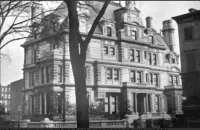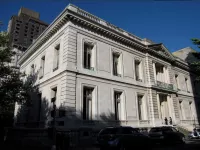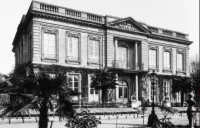Share what you know,
and discover more.
Share what you know,
and discover more.
Apr 11, 2023

-

- Charmaine Bantugan
Henry H. Cook Mansion
Built 1883, for Henry Harvey Cook (1822-1905) and his wife Mary McCay (1827-1902). Having made his fortune in railroads and banking, Cook moved into real estate. His multi-colored granite mansion was designed by W. Wheeler Smith (1838-1908), but it barely lived longer than he did and rumor had it that even he was bored of it by 1900. In 1909, it was purchased by tobacco magnate James Buchanan Duke (1856-1925) who promptly demolished it to build the James B. Duke House, a Beaux-Arts masterpiece for his new wife. As the wrecking ball got under-away, an elderly passerby commented with disdain, "they don't put buildings up that way now" - James Duke may have differed, and Ralph Lauren has done his best to dispel that theory too.... In 1880, Cook purchased an entire block in Manhattan for $500,000, but it was not just any block: Cook's block covered the area from Fifth to Madison and 78th to 79th Streets. His own house on the north-east corner of Fifth and East 78th was originally intended to be one four that would mark out each corner of his fiefdom, but that plan never materialized. It was built of white, blue and red granite stone, stacked to create a pattern. Architectural commentators of the time had mixed reviews of Cook's mansion: the fake chimney that crowns the center of the facade springs improbably from a dormer window, drew particular criticism. But another forgave its architectural misdoings passing it as, "respectable in spite of its monotony and the irrationality of its detail". By the start of the new century, Cook had become envious of the new Beaux-Arts mansions being put up in Manhattan, in particularly the newly remodelled Whitney Mansion at 871 Fifth Avenue. He asked its designers, McKim, Mead & White, to come up with plans for something similar for him to be built at 973 Fifth Avenue. But, this never came to fruition and instead he retired to Wheatleigh in The Berkshires. Ironically, the demolition of Cook's own mansion in favor of the James B. Duke House was the last major residential change to the Cook Block - which remains as possibly the grandest surviving enclave of what was Gilded Age New York.
Henry H. Cook Mansion
Built 1883, for Henry Harvey Cook (1822-1905) and his wife Mary McCay (1827-1902). Having made his fortune in railroads and banking, Cook moved into real estate. His multi-colored granite mansion was designed by W. Wheeler Smith (1838-1908), but it barely lived longer than he did and rumor had it that even he was bored of it by 1900. In 1909, it was purchased by tobacco magnate James Buchanan Duke (1856-1925) who promptly demolished it to build the James B. Duke House, a Beaux-Arts masterpiece for his new wife. As the wrecking ball got under-away, an elderly passerby commented with disdain, "they don't put buildings up that way now" - James Duke may have differed, and Ralph Lauren has done his best to dispel that theory too.... In 1880, Cook purchased an entire block in Manhattan for $500,000, but it was not just any block: Cook's block covered the area from Fifth to Madison and 78th to 79th Streets. His own house on the north-east corner of Fifth and East 78th was originally intended to be one four that would mark out each corner of his fiefdom, but that plan never materialized. It was built of white, blue and red granite stone, stacked to create a pattern. Architectural commentators of the time had mixed reviews of Cook's mansion: the fake chimney that crowns the center of the facade springs improbably from a dormer window, drew particular criticism. But another forgave its architectural misdoings passing it as, "respectable in spite of its monotony and the irrationality of its detail". By the start of the new century, Cook had become envious of the new Beaux-Arts mansions being put up in Manhattan, in particularly the newly remodelled Whitney Mansion at 871 Fifth Avenue. He asked its designers, McKim, Mead & White, to come up with plans for something similar for him to be built at 973 Fifth Avenue. But, this never came to fruition and instead he retired to Wheatleigh in The Berkshires. Ironically, the demolition of Cook's own mansion in favor of the James B. Duke House was the last major residential change to the Cook Block - which remains as possibly the grandest surviving enclave of what was Gilded Age New York.
Apr 11, 2023
Henry H. Cook Mansion
Built 1883, for Henry Harvey Cook (1822-1905) and his wife Mary McCay (1827-1902). Having made his fortune in railroads and banking, Cook moved into real estate. His multi-colored granite mansion was designed by W. Wheeler Smith (1838-1908), but it barely lived longer than he did and rumor had it that even he was bored of it by 1900. In 1909, it was purchased by tobacco magnate James Buchanan Duke (1856-1925) who promptly demolished it to build the James B. Duke House, a Beaux-Arts masterpiece for his new wife. As the wrecking ball got under-away, an elderly passerby commented with disdain, "they don't put buildings up that way now" - James Duke may have differed, and Ralph Lauren has done his best to dispel that theory too....In 1880, Cook purchased an entire block in Manhattan for $500,000, but it was not just any block: Cook's block covered the area from Fifth to Madison and 78th to 79th Streets. His own house on the north-east corner of Fifth and East 78th was originally intended to be one four that would mark out each corner of his fiefdom, but that plan never materialized. It was built of white, blue and red granite stone, stacked to create a pattern.
Architectural commentators of the time had mixed reviews of Cook's mansion: the fake chimney that crowns the center of the facade springs improbably from a dormer window, drew particular criticism. But another forgave its architectural misdoings passing it as, "respectable in spite of its monotony and the irrationality of its detail".
By the start of the new century, Cook had become envious of the new Beaux-Arts mansions being put up in Manhattan, in particularly the newly remodelled Whitney Mansion at 871 Fifth Avenue. He asked its designers, McKim, Mead & White, to come up with plans for something similar for him to be built at 973 Fifth Avenue. But, this never came to fruition and instead he retired to Wheatleigh in The Berkshires.
Ironically, the demolition of Cook's own mansion in favor of the James B. Duke House was the last major residential change to the Cook Block - which remains as possibly the grandest surviving enclave of what was Gilded Age New York.
Posted Date
Apr 10, 2023
Historical Record Date
Apr 11, 2023
Source Name
House Histree
Source Website
Delete Story
Are you sure you want to delete this story?
Mar 22, 2023
Mar 22, 2023

-

- Charmaine Bantugan
James B. Duke House
Completed in 1912, for James Buchanan Duke (1857-1925) as a wedding present for his second wife, Nannie Holt (1871-1962). Standing at the north-east corner of Fifth Avenue & East 78th Street, this 40,000 square foot mansion is an almost identical replica of the 18th Century Chateau Labottière in Bordeaux. The original house that stood in its place, the Henry H. Cook Mansion, was demolished to make way for Duke's. Impressed by The Elms at Newport, Duke commissioned the master of American Beaux Arts architecture, Horace Trumbauer to design his new home. The plans were drawn up by Julian Abele (1881-1950), the first professional African-American architect. Since 1952, the mansion has served as New York University's Institute of Fine Arts after being donated by Duke family. The Duke House was cited as one the mansions that inspired Ralph Lauren's modern masterpiece at 888 Madison Avenue.
James B. Duke House
Completed in 1912, for James Buchanan Duke (1857-1925) as a wedding present for his second wife, Nannie Holt (1871-1962). Standing at the north-east corner of Fifth Avenue & East 78th Street, this 40,000 square foot mansion is an almost identical replica of the 18th Century Chateau Labottière in Bordeaux. The original house that stood in its place, the Henry H. Cook Mansion, was demolished to make way for Duke's. Impressed by The Elms at Newport, Duke commissioned the master of American Beaux Arts architecture, Horace Trumbauer to design his new home. The plans were drawn up by Julian Abele (1881-1950), the first professional African-American architect. Since 1952, the mansion has served as New York University's Institute of Fine Arts after being donated by Duke family. The Duke House was cited as one the mansions that inspired Ralph Lauren's modern masterpiece at 888 Madison Avenue.
James B. Duke House
Completed in 1912, for James Buchanan Duke (1857-1925) as a wedding present for his second wife, Nannie Holt (1871-1962). Standing at the north-east corner of Fifth Avenue & East 78th Street, this 40,000 square foot mansion is an almost identical replica of the 18th Century Chateau Labottière in Bordeaux. The original house that stood in its place, the Henry H. Cook Mansion, was demolished to make way for Duke's. Impressed by The Elms at Newport, Duke commissioned the master of American Beaux Arts architecture, Horace Trumbauer to design his new home.The plans were drawn up by Julian Abele (1881-1950), the first professional African-American architect. Since 1952, the mansion has served as New York University's Institute of Fine Arts after being donated by Duke family. The Duke House was cited as one the mansions that inspired Ralph Lauren's modern masterpiece at 888 Madison Avenue.
Posted Date
Mar 22, 2023
Historical Record Date
Mar 22, 2023
Source Name
House Histree
Source Website
Delete Story
Are you sure you want to delete this story?











